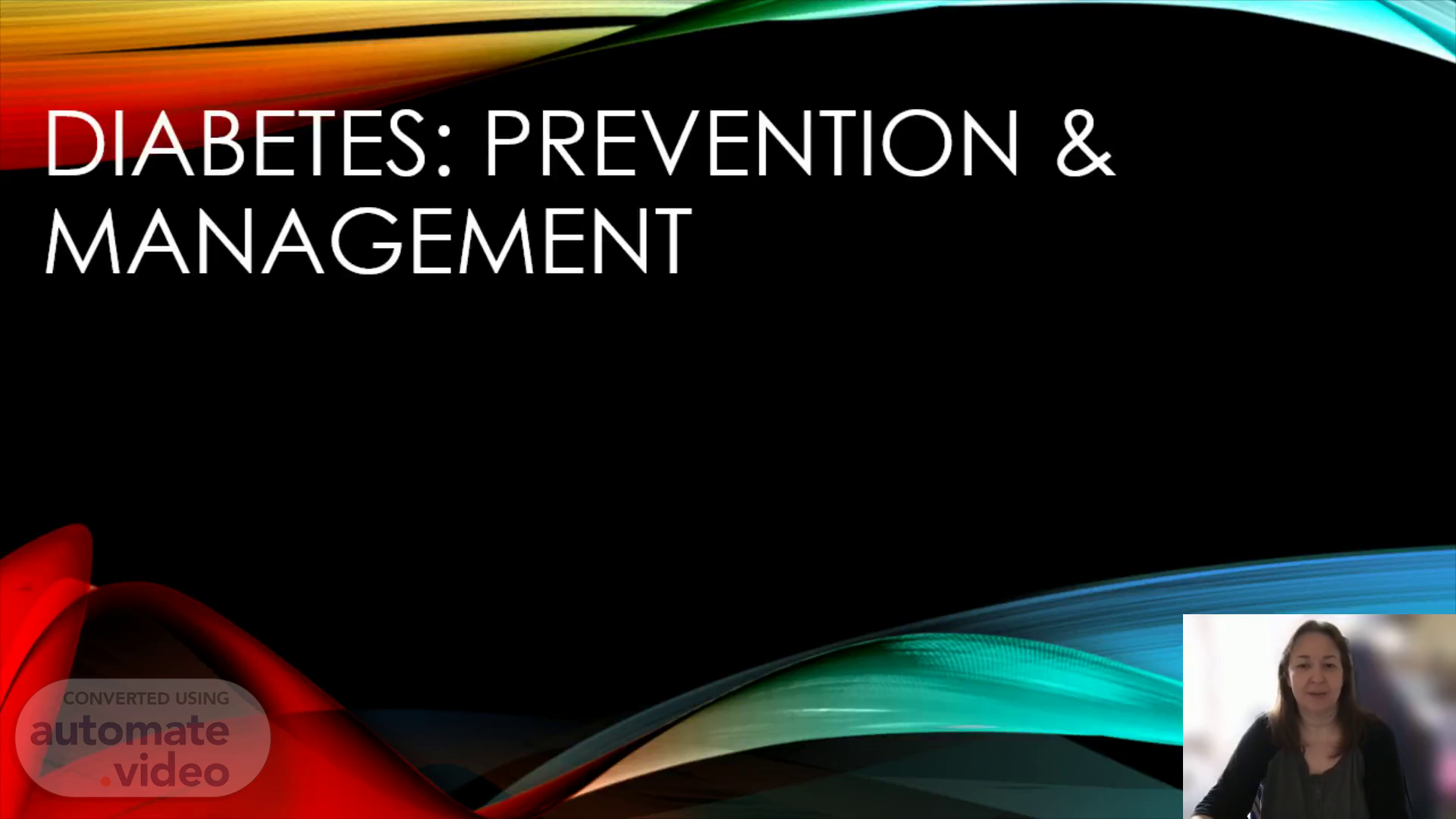
Diabetes: Prevention & Management
Scene 1 (0s)
Diabetes: Prevention & Management. Michelle Bonnes LPN to BSN student Indiana State University N444- Community Health Nursing Spring 2022.
Scene 2 (25s)
Population at risk:. All persons with family history of diabetes Modifiable risk factors: being overweight and leading a sedentary lifestyle Age, gender, ethnicity = not modifiable -African Americans, Native Americans, Pacific Islanders at greatest risk Diagnosed with prediabetes: it can be reversed!.
Scene 3 (1m 10s)
Some basic Facts:. As of 2021, the CDC reports 37.3 million people in US have diabetes (approximately 11.3% of the population) Another 96 million people, over the age of 18, were found the have “pre-diabetes” Diabetes is manageable with the right combination of diet, exercise, and proper follow up with your physician Some may require medications as form of treatment as well.
Scene 4 (2m 10s)
Learning objectives. By the end of this presentation, the participant will be able to: Identify common symptoms recognized in those diagnosed with diabetes. Identify the optimal time frame recommended for routine follow up with their primary care provider. Identify the foods that are recommended to eat in moderation or avoid to prevent blood sugar instability. Identify the benefits of attaining an optimal weight level and the importance of maintaining their weight. Identify accessbile resources for diet exchanges, further education, and weight management..
Scene 5 (2m 52s)
Pause and take pre-test please. Doctor using digital tablet in a hospital corridor.
Scene 6 (3m 19s)
What is Diabetes? - a condition where the body fails to properly manage blood sugar levels Can be managed with diet/exercise, some require medications.
Scene 7 (3m 50s)
Typical symptoms:. Increased thirst, increased urination (polydipsia, polyuria) Increased appetite Dizziness Headache Nausea Skin changes (warm/flushed if high blood sugar, cold/clammy if low blood sugar) Feeling jittery or shaky.
Scene 8 (4m 37s)
How do they test for diabetes?. Typically discovered during routine exam via blood tests and a thorough medical history by primary care provider Recommended lab tests: Fasting blood glucose a. normal: 60-100mg/dL b. prediabetes:100-125mg/dL c. diabetes: 126mg/dL or higher 2. Hemoglobin A1c a. normal: less than 5.7% b. prediabetes: 5.7-6.4% c. diabetes: 6.5% or higher.
Scene 9 (6m 4s)
Prevention:. According to American Diabetes Association, risk factors can be reduced by 58% if: Weight reduction by at least 7% of current total Moderate exercise, such as a brisk walk, for 30 minutes, up to 5x/weekly Moderate dietary intake to lower overall carbohydrate consumption, lower fat, increasing dietary fiber.
Scene 10 (6m 45s)
Treatment:. Depends on A1c levels, typically will include routine blood tests and possibly fingerstick blood glucose monitoring at home Can be diet controlled alone if A1c low enough May need medications by mouth or injectable insulin if higher than 7% Follow up with your primary doctor closely until stabilized.
Scene 11 (8m 3s)
Blood sugar monitoring. If you have been diagnosed with diabetes: Check with your doctor on how often to perform fingerstick blood sugar testing. Typically, daily in the morning for those not on insulin Ideally at least 2-4 times daily if on insulin Bring your glucose meter or blood sugar test results log to all of your appointments for review and possible medication adjustment.
Scene 12 (8m 32s)
Nutrition:. Lowering your carbohydrate and fat intake doesn’t mean you have to “starve” yourself. There are better alternatives to commonly eaten foods: 1. Multigrain or whole grain instead of white bread or pastas 2. Cauliflower instead of rice 3. Avoid sugar laden drinks such as fruit juices, sodas, and sweetened iced tea 4. Increase your protein and non-starchy vegetable intake 5. Try plain Greek yogurt in place of sour cream ETC….
Scene 13 (8m 48s)
Exercise:. Moderate exercise 3-5 times a week recommended Some may have physical limitations, work with your doctor on what you can safely maintain (many with arthritis , for example, can tolerate water-based activities without added stress on joints) Consider classes at local community center or aquatics center.
Scene 14 (9m 9s)
When to Follow up. Per the CDC and American Diabetes Association, blood levels should be monitored twice a year, at minimum. Those with higher A1c, more often. People with difficult to manage diabetes may be referred to a specialist, called an endocrinologist, for closer monitoring. When in doubt, check with your primary care provider.
Scene 15 (9m 30s)
Resources for further education:. American Diabetes Association (ADA) at www.diabetes.org Advice on nutrition, understanding your disease, ways to manage, questions you may have for your doctor Centers for Disease Control (CDC) at www.cdc.org Statistics, current management recommendations, nutrition Your primary doctor can refer you to a diabetic educator or a nutrition specialist for more personalized advice Some offices consult with a pharmacist for medication recommendations based on current A1c and glucometer readings.
Scene 16 (9m 50s)
References. American Diabetes Association. (n.d.). Prediabetes | ADA . www.diabetes.org. https://www.diabetes.org/diabetes/prediabetes American Diabetes Association. (2019). Type 2 Diabetes - Symptoms, Causes, Treatment . Diabetes.org. https://www.diabetes.org/diabetes/type-2 American Diabetes Association. (2021). Recipes & Nutrition | ADA . www.diabetes.org. https://www.diabetes.org/healthy-living/recipes- nutrition Centers for Disease Control. (2019). Living with Diabetes . Centers for Disease Control. https://www.cdc.gov/diabetes/managing/index.html Centers for Disease Control. (2020, September 28). National Diabetes Statistics Report, 2020 | CDC . Www.cdc.gov. https://www.cdc.gov/diabetes/data/statistics-report/.